 |
 |
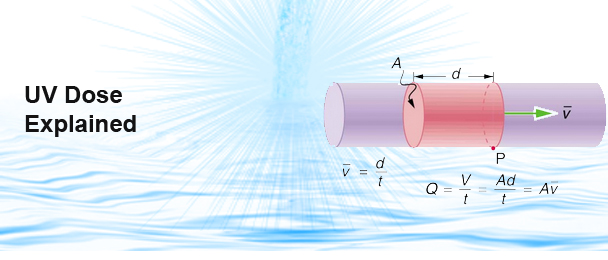 |
 |
|
May 21, 2019
We often get questions regarding the UV Dose and how it should be used to help determine a properly sized UV disinfection system for any water treatment application. This article aims to help explain the concept of UV Dose and how to use it.
|
|
The UV Dose is nothing more than a measurement of how much UV light energy (at the germicidal wavelength of 254nm) is applied to the water stream as it flows through the UV chamber. UV light energy must pass through the complete water stream so that all of the water inside the chamber is disinfected.
The UV Dose (technically referred to as "fluence") is measured in mJ/cm2 of water and there are several recommended UV Dose standards out there as noted in a previous article.
|
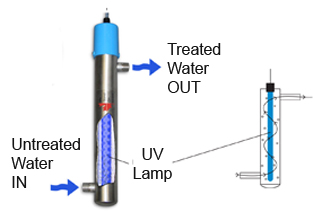 |
|
There are many factors that can make it more difficult for the UV light energy to pass through the water including sediments in the water, dissolved minerals and more. When we discuss how much UV light energy can pass through the water we are really discussing the % UVT of the water (this stands for percent Ultra Vilolet Transmittance).
|
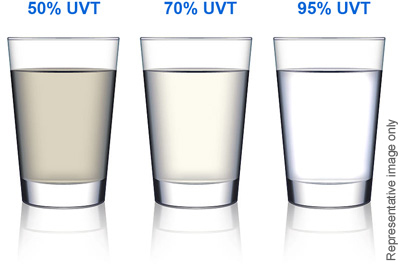 |
UVT is measured by a spectrophotometer in a lab and the higher the UVT the more UV light energy can pass through the water unimpeded. Conversely the lower the UVT the less UV light energy can penetrate the water resulting in a lower UV Dose applied.
|
|
The second major factor in determining the UV Dose applied is the expected flow rate through the UV chamber. UV Dose is calculated from a large number of input data including the amount of time the water stays in the UV chamber being exposed to UV light energy (this is called the "hydraulic residence time") and is calculated from among other things the physical size of the UV chamber itself. As you can imagine the longer the water remains in the UV chamber the more UV light it is exposed to and the higher the UV Dose applied.
|
|
Now that we have data on UVT and flow rate, with the use of a sophisticated algorithm we can then accurately calculate the UV Dose that will be applied to the water in any given UV disinfection application. The graphs we have plotted here represent UV Dose applied (by UV model) at 3 different UVT's. This extended data is very useful when it comes to selecting the proper UV for the job.
|
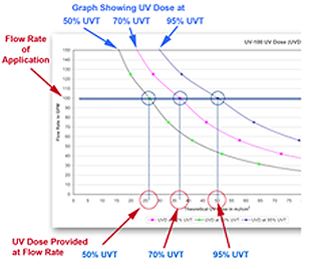
|
|
The next question is logically, what UV Dose should we aim for?
The basic idea of UV is that because UV is non-chemical, the higher the UV Dose the better and in most cases that is true up to a point. It is required to provide at the very least enough UV Dose to achieve a 3-log reduction (99.9% reduction) of the target pathogen, and most often this is exceeded by 2x or 3x or more in order to provide an extra level of protection and to address other pathogens that may be present in the water.
A high UV dose is never problematic as there is not an overdose issue when using UV as a disinfectant.
See our UV Inactivation ChartDose for UV dose required by pathogen.
Let's look at some expamples of UV Dose application:
Example 1 - Remove E. coli bacteria from water with 70% UVT at 40 GPM Flow Rate
| Pathogen: |
E. coli |
UV Dose required
for 3-log reduction: |
8.6 mJ/cm2 |
| UVT of Water: |
70% UVT |
| Expected Flow Rate: |
40 GPM (151 LPM) |
| UV Unit Selected: |
Wyckomar UV-5000 |
| UV Dose achieved: |
27.8 mJ/cm2
(or 3.2x required minimum UV Dose for 3-log reduction) |
|
UV-5000 Dose Chart
(flow rate of 40 GPM / 151 LPM and UV Dose of 27.8 mJ/cm2 highlighted on 70% UVT graph)
|
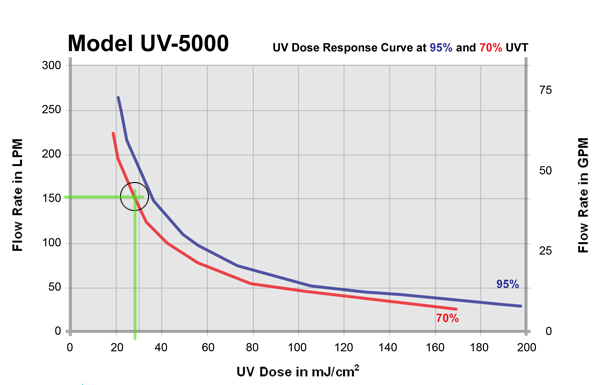
|
Example 2 - Remove Adenovirus from water with 95% UVT at 50 GPM Flow Rate
| Pathogen: |
Adenovirus |
UV Dose required
for 3-log reduction: |
90 mJ/cm2 |
| UVT of Water: |
95% UVT |
| Expected Flow Rate: |
50 GPM (189 LPM) |
| UV Unit Selected: |
Wyckomar UV-100 |
| UV Dose achieved: |
180 mJ/cm2
(or 2.0x required minimum UV Dose for 3-log reduction) |
|
UV-100 Dose Chart
(flow rate of 50 GPM / 189 LPM and UV Dose of 180 mJ/cm2 highlighted on 95% UVT graph)
|
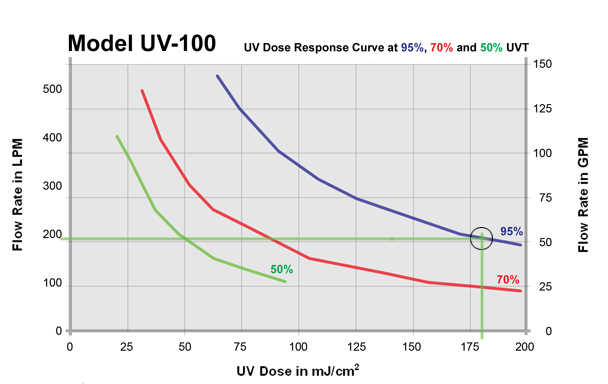
|
Example 3 - Remove Cryptosporidium from water with 70% UVT at 150 GPM Flow Rate
| Pathogen: |
Cryptosporidium |
UV Dose required
for 3-log reduction: |
12 mJ/cm2 |
| UVT of Water: |
70% UVT |
| Expected Flow Rate: |
150 GPM (568 LPM) |
| UV Unit Selected: |
Wyckomar UV-5007 |
| UV Dose achieved: |
41 mJ/cm2
(or 3.4x required minimum UV Dose for 3-log reduction) |
|
UV-5007 Dose Chart
(flow rate of 150 GPM / 568 LPM and UV Dose of 41 mJ/cm2 highlighted on 70% UVT graph)
|
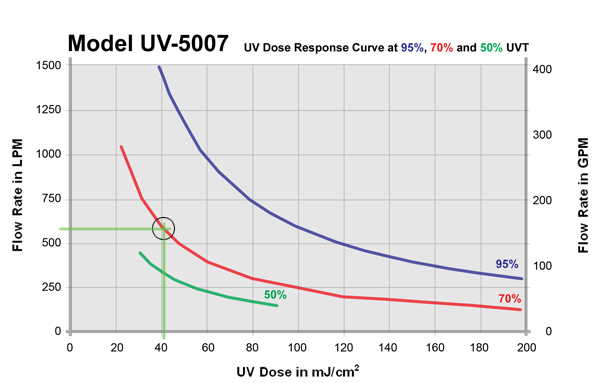
|
Example 4 - Remove Hepatitis Virus from water with 95% UVT at 12 GPM Flow Rate
| Pathogen: |
Hepatitis Virus |
UV Dose required
for 3-log reduction: |
15 mJ/cm2 |
| UVT of Water: |
95% UVT |
| Expected Flow Rate: |
12 GPM (45 LPM) |
| UV Unit Selected: |
Wyckomar UV-1400 |
| UV Dose achieved: |
56 mJ/cm2
(or 3.5x required minimum UV Dose for 3-log reduction) |
|
UV-1400 Dose Chart
(flow rate of 12 GPM / 45 LPM and UV Dose of 56 mJ/cm2 highlighted on 95% UVT graph)
|
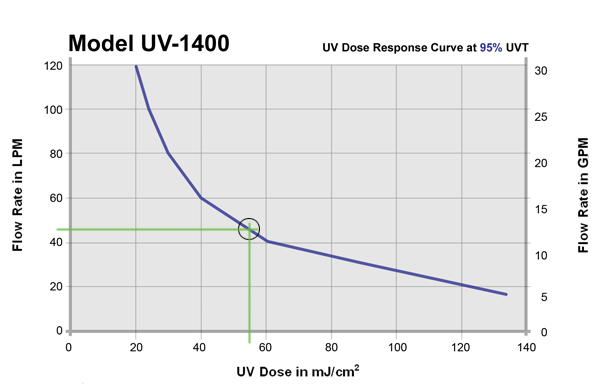
|
Example 5 - Remove Polio Virus from water with 50% UVT at 50 GPM Flow Rate
| Pathogen: |
Polio Virus |
UV Dose required
for 3-log reduction: |
27 mJ/cm2 |
| UVT of Water: |
50% UVT |
| Expected Flow Rate: |
50 GPM (189 LPM) |
| UV Unit Selected: |
Wyckomar UV-100 |
| UV Dose achieved: |
49 mJ/cm2
(or 1.8x required minimum UV Dose for 3-log reduction) |
|
UV-100 Dose Chart
(flow rate of 50 GPM / 189 LPM and UV Dose of 49 mJ/cm2 highlighted on 50% UVT graph)
|
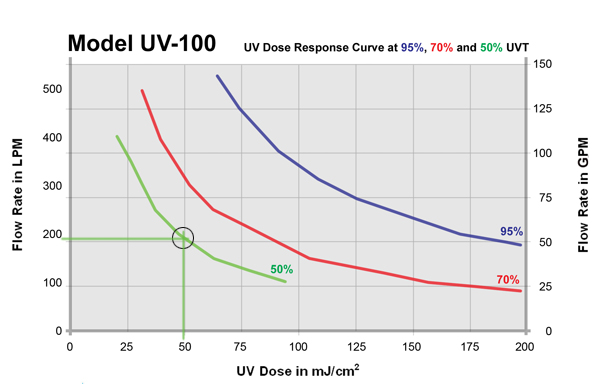
|
|
|
We hope this helps illustrate the importance of knowing the UV dose required and applied for your UV disinfection application.
Please refer to our Flow-Range Tables to help select the proper UV unit for your disinfection application.
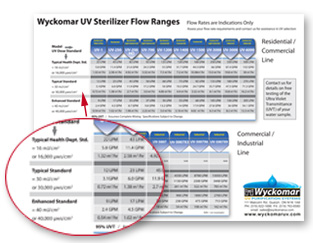
|
|
Please contact the sales desk sales@wyckomaruv.com for more information
|
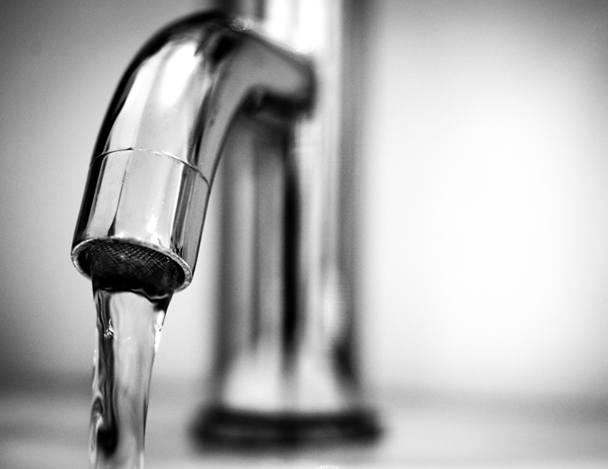
Wyckomar UV Purification Systems | 111 Malcolm Road | Guelph, ON, Canada N1K 1A8
Phone: (519) 822-1886 | Fax: (519) 763-6580
| sales@wyckomaruv.com | www.wyckomaruv.com


You are receiving this email as a special service for dealers of Wyckomar Inc.
If you believe you have received this email in error or if you wish to unsubscribe from the
email distribution list, please notify us in a reply to this email, stating "unsubscribe" in
the email subject. Thank you for your cooperation.
|
 |
 |
 |
 |
 |
 |












